CHARLES DICKENS and CAPTAIN GOLDSMITH at GADSHILL
Exactly one year ago, on December 10th, 2014, the mail box set into the wall outside Charles Dicken's house at 6 Gadshill Place, in the village of Higham, Kent (UK) where he died on the 9th June 1870, was recommissioned by the Royal Mail after more than twenty years of standing idle, decommissioned in the 1990s. The Charles Dickens Centre (Gads Hill) Charitable Trust, and the Letter Box Study Group alerted Royal Mail to the historical and cultural significance of the postbox, and asked if it could be put back into service.
To commemorate the occasion, a plaque was attached next to the box, stating that -
‘This letterbox outside Gad’s Hill Place, home of Charles Dickens, was used by the author and his family between 1859 and 1870.- and a special postmark was applied to mail posted in the box from the 15th to 18th December 2014 bearing the letters ‘CD’, in tribute to the way Dickens used to seal his mail before he posted it.
‘Proudly restored in his memory by Royal Mail, 10.12.14’
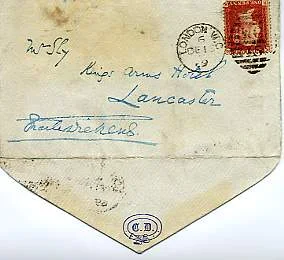

Source: right: The short-term handstamp, "CD" Postmark Bulletin, London Special Handstamp Centre, Ref 13298.
Source: left: Envelope front to Mr Sly, dated 1st October 1869. John Wilson Manuscripts
The postbox was officially opened by great-great granddaughter Marion Dickens who said on posting the first letter:
"In our digital world, handwritten letters are more appreciated than ever. Being able to post mine in the letterbox regularly used by my great-great-grandfather makes me feel thrillingly close to him.Source: The postbox of Christmas past: Royal Mail recommissions Charles Dickens’ postbox
He wrote a dozen letters every day and made excellent use of this box, and the new postal services that were developing all over the country in his lifetime.
144 years after he posted his last letter from Gad’s Hills, it’s wonderful that the Royal Mail have made it possible for me to do exactly the same..."

Source: Charles Dickens’s personal postbox, outside his Kent home, has been recommissioned ahead of Christmas. Photograph: Royal Mail/PA
Source: Video at YouTube: Charles Dickens postbox reopened at Gad's Hill
Connections past and present
On January 18th, 2014, this weblog posted an article with reference to two of Charles Dickens' letters complaining about his neighbour, retired master mariner Captain Edward Goldsmith at Gadshill, in the village of Higham, Kent (UK). The first letter dated 1857 concerned Captain Goldsmith's monopoly of the water supply in the village, and the second dated 1859 concerned the location of the village mailbox outside Captain Goldsmith's house. It took just a few months in 2014, from January when we first posted the reference to Captain Goldsmith and the Higham mailbox in Charles Dickens' letters, to December 2014 when this now famous mailbox found restitution as a fully operational service of the Royal Mail. Perhaps we played a small part in bringing the mailbox back into service. Our generous Captain Goldsmith, without doubt, is the ancestor who keeps on giving.
For Captain Goldsmith's nieces Elizabeth Rachel Day and Mary Sophia Day, daughters of Captain Goldsmith's wife's brother, Captain James Day back in Tasmania, the relocation of the mailbox from Captain Goldsmith's house to the wall outside Dickens' house in 1859 would have been more than newsworthy concerning this famous neighbour of their illustrious uncle. It meant he would not be as closely associated with their family mail arriving and leaving the village as before. Both nieces at Captain Goldsmith's death in 1869, including photographer Thomas Nevin, husband of his niece Elizabeth Rachel Day, were named as beneficiaries to eleven houses in Vicarage Row (Kent) in Captain Goldsmith's will, an indication that correspondence between these family members in Hobart Tasmania and Higham Kent was constant from February 1856 when Captain Goldsmith, his wife Elizabeth and son Edward Goldsmith jnr departed Tasmania for good to settle permanently at Gadshill.
Extracts from Captain Edward Goldsmith's will:


Pages 1,Captain Edward Goldsmith's will, 1871 and Bill of Complaint 1872
(Ref: National Archives UK C16/781 C546012)
TRANSCRIPT Frontispiece 1872
1872 D. 50
In Chancery
Between Mary Sophia Day (an infant under the age of 21 years) by Thomas Butler her next friend .. Plaintiff
and
Elizabeth Goldsmith, William Bell Bentley, Alfred Bentley, Edward Goldsmith and Sarah Jane his wife, Caroline Tolhurst, Matilda Tolhurst (inserted), Edward Tolhurst, Richard Tolhurst and Thomas Nevin and Elizabeth Rachel his wife (the four last named defendants being out of the jurisdiction of this Honorable Court) ... Defendants
I the undersigned Thomas Butler of No. 9 The Grove Gravesend in the County of Kent Genteleman (inserted) hereby authorize and request you Mr Thomas Sismey of No. 11 Sergeants Inn Fleet Street in the City of London Solicitor to institute the above suit on behalf of the above named infant plaintiff Mary Sophia Day who is now residing at Hobart Town in Tasmania and is a spinster and to use my name as her next friend for such purpose
Dated this twenty fifth day of March 1872
Thomas Butler
Page 4 of Captain Goldsmith's will re Vicarage Row.
Captain Goldsmith's will to bequeath 11 houses to Thomas and Elizabeth Nevin in Vicarage Row, near Gravesend. Google maps 2013.
On retirement from the merchant marine trade in 1856, Captain Edward Goldsmith (1808-1869) returned to the area around Chalk in Kent where he was born, settling back at Higham with Elizabeth his wife, to oversee his extensive freehold and leasehold properties. They were resident once more at Gads Hill House by 1857 when Charles Dickens made mention of Captain Goldsmith's abundant water supply, but by the 1861 Census, the Goldsmiths' were resident at Higham Lodge while renovations were made to Gads Hill House. The brick wall of Higham Lodge is visible in this postcard view (1905), adjacent to the Sir John Falstaff Inn at the corner of Telegraph Hill and Gravesend Road when the inn's wall was plastered with theatrical bills.
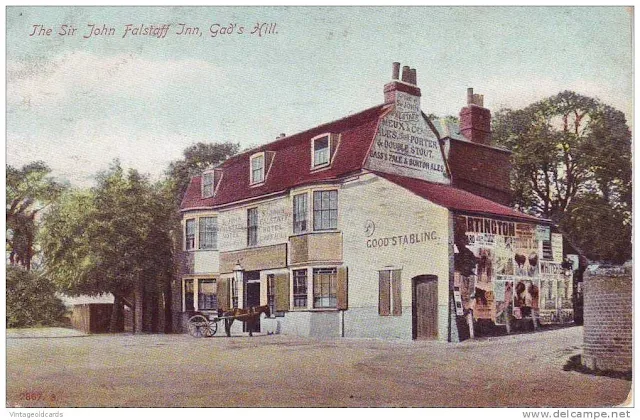
Postcard: Sir John Falstaff Inn, Gad's Hill, Published by Hartmann Saxony, 1905

Postcard, Gad's Hill, 1907. Source: CityArk, Medway, UK.
1861 UK Census: Captain Edward Goldsmith, retired master mariner, age 56, resident of Higham Lodge, together with his wife Elizabeth, age 54, and servant Louisa Eatten, age 21.

Higham Lodge
Source: Medway Archives, Couchman Collection. Ref: DE 402/24/37 (L)
Higham Lodge and conservatory is clearly seen in this undated photograph taken before the cedar trees further down the Gravesend Road were removed in 1907.
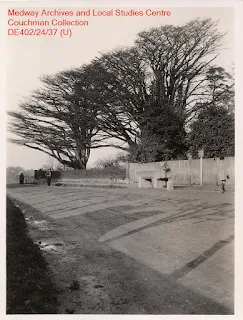

Source: Medway Archives, Couchman Collection
The Gravesend Road, Gadshill cedars trees where Dickens' chalet was located.
Those cedar trees were located in the "Shrubbery" opposite Charles Dickens' house, accessed from No. 6 Gad's Hill Place by a tunnel under the road leading to his Chalet, 1865-1870. Dickens referred to the chalet's location as his "Wilderness", so it was not without an ironic nod to Dickens when John Nevin snr, father of photographer Thomas J. Nevin and soon-to-be father-in-law of Elizabeth Rachel Day, Captain Goldsmith''s niece, published his poem titled "My Cottage in the Wilderness" in 1868, referring to the family home he built in a real wilderness situated on land next to Lady Franklin's museum at Kangaroo Valley, Hobart, Tasmania.
Higham Lodge, foreground on right, Falstaff Inn on right in distance opposite Dickens' former house, Gadshill Place, now a school with sign where the mail box is located a little further down the Gravesend Road. Google maps 2013.
Gads Hill House was listed in Captain Goldsmith's will, 1869, as leased to Mr Andrew Chalmers Dods on a piece of land measuring 6a, 3r, 28p which was undergoing extensions and enlargement, payment for which was to be executed out of the Captain's other estates, excluding Vicarage Row. Originally named Mount Prospect, Gads Hill House was located at the top of Telegraph Hill with commanding views of the Medway to the north and Cobham Hall to the south west, hence Charles. Dickens' description of it as "that crow's-nest of a house". Outside the gates was a beacon and a ship's bell on a metal stand at the front door. Although Captain Goldsmith was one of the first owners of the house, if not the original owner in 1825, Mr John Townsend, MP for Greenwich and a Shakespearian actor of note ca. 1842, was thought to reside there. Captain Goldsmith's generosity in easing Townsend's considerable debts, among other acts of kindness in the district for which the Captain was known, was mentioned by Cecil Fielding in 1882 on page 7 of his publication, A Hand-book of Higham: Or the Curiosities of a Country Parish.
Cecil Fielding on Captain Goldsmith at Gadshill, A Hand-book of Higham: Or the Curiosities of a Country Parish (1882: 7)
A real estate journalist described Gads Hill House in these terms in 2002:
Gads Hill House, near Rochester, Kent. A long, sweeping drive, six bedrooms, magnificent full-length hall, huge reception rooms - what more could a City commuter want in a country residence? Land? There are more than four acres of woodland and gardens, including a croquet lawn and orchard. Somewhere to lay down the claret? There are three cellars and a wine store. And with regular commuter trains from Higham, two miles away, to London, you could still be back to bath the kids.In 2009, Gads Hill House Telegraph Hill, Rochester, Gravesham, Kent, ME3 7NW was the most expensive house purchase in Telegraph Hill, sold for £1,395,000.
What remains of Captain Goldsmith's property at Gads Hill.
Gads Hill House with yellow gravel in front and acreage behind
Google maps capture 2016
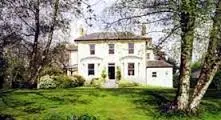

Captain Goldsmith's will 1872, Item 7: Gadshill House
Charles Dickens' Water Supply and the Letter Box
When Charles Dickens (1812-1870) settled finally into the house at 6 Gad's Hill Place, Higham, Kent (UK) in 1857, his attention was drawn to Captain Goldsmith on two most urgent matters - the water supply to his house and the location of the mail box, both of which Captain Goldsmith seemed to monopolise.
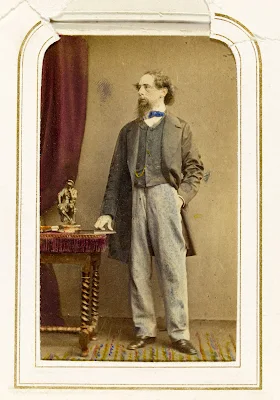
Victoria & Albert Museum
Charles Dickens,
Coloured albumen carte-de-visite, J & C Watkins,[1863]
Museum no. 1712:21-1956
At first, Dickens' excitement at buying the property knew no bounds. These extracts are from his letters. On January 17th, 1857, he wrote -
[Sidenote: M. de Cerjat.]
TAVISTOCK HOUSE, _Monday Night, Jan, 17th, 1857
MY DEAR CERJAT,
...Down at Gad's Hill, near Rochester, in Kent--Shakespeare's Gad's Hill,
where Falstaff engaged in the robbery--is a quaint little country-house
of Queen Anne's time. I happened to be walking past, a year and a half
or so ago, with my sub-editor of "Household Words," when I said to him:
"You see that house? It has always a curious interest for me, because
when I was a small boy down in these parts I thought it the most
beautiful house (I suppose because of its famous old cedar-trees) ever
seen. And my poor father used to bring me to look at it, and used to say
that if I ever grew up to be a clever man perhaps I might own that
house, or such another house. In remembrance of which, I have always in
passing looked to see if it was to be sold or let, and it has never been
to me like any other house, and it has never changed at all." We came
back to town, and my friend went out to dinner. Next morning he came to
me in great excitement, and said: "It is written that you were to have
that house at Gad's Hill. The lady I had allotted to me to take down to
dinner yesterday began to speak of that neighbourhood. 'You know it?' I
said; 'I have been there to-day.' 'O yes,' said she, 'I know it very
well. I was a child there, in the house they call Gad's Hill Place. My
father was the rector, and lived there many years. He has just died, has
left it to me, and I want to sell it.' 'So,' says the sub-editor, 'you
must buy it. Now or never!'" I did, and hope to pass next summer there,
though I may, perhaps, let it afterwards, furnished, from time to time....
But serious issues soon emerged "on the great estate" a few months later. On June 6th, he wrote -
[Sidenote: Mr. Henry Austin.]
GAD'S HILL, _Saturday, June 6th, 1857._
MY DEAR HENRY,
Here is a very serious business on the great estate respecting the water
supply. Last night, they had pumped the well dry merely in raising the
family supply for the day; and this morning (very little water having
been got into the cisterns) it is dry again! It is pretty clear to me
that we must look the thing in the face, and at once bore deeper, dig,
or do some beastly thing or other, to secure this necessary in
abundance. Meanwhile I am in a most plaintive and forlorn condition
without your presence and counsel. I raise my voice in the wilderness
and implore the same!!!
Wild legends are in circulation among the servants how that Captain
Goldsmith on the knoll above--the skipper in that crow's-nest of a
house--has millions of gallons of water always flowing for him. Can he
have damaged my well? Can we imitate him, and have our millions of
gallons? Goldsmith or I must fall, so I conceive.
If you get this, send me a telegraph message informing me when I may
expect comfort. I am held by four of the family while I write this, in
case I should do myself a mischief--it certainly won't be taking to
drinking water.
Ever affectionately (most despairingly).
In a letter to Henry Austin on 15 August 1857, the water supply problem had been solved with a bore. Dickens wrote -
[Sidenote: Mr. Henry Austin.]The cause of the water supply problem for Dickens' house at Gads Hill Place at the bottom of Telegraph Hill is best explained by former resident Carole Turner in the 1980s of Captain Goldsmith's Gads Hill House at the top of Telegraph Hill:
GAD'S HILL PLACE, _Saturday, Aug. 15th, 1857.
MY DEAR HENRY,
At last, I am happy to inform you, we have got at a famous spring!! It
rushed in this morning, ten foot deep. And our friends talk of its
supplying "a ton a minute for yourself and your family, sir, for
nevermore."
They ask leave to bore ten feet lower, to prevent the possibility of
what they call "a choking with sullage." Likewise, they are going to
insert "a rose-headed pipe;" at the mention of which implement, I am
(secretly) well-nigh distracted, having no idea of what it means. But I
have said "Yes," besides instantly standing a bottle of gin. Can you
come back, and can you get down on Monday morning, to advise and
endeavour to decide on the mechanical force we shall use for raising the
water? I would return with you, as I shall have to be in town until
Thursday, and then to go to Manchester until the following Tuesday.
I send this by hand to John, to bring to you.
The water table at the top of the hill was very high and the cellars of the house regularly flooded. The strange thing was that they only flooded in times of drought not in times of very wet weather. I researched it and there is a suggestion that in drought times they stopped pumping from Higham marshes and this somehow caused the water table to rise at the top of the hill. Presumably properties at the bottom i.e Dickens Gads Hill Place would have had empty wells. There were three wells at Gads Hill House and they were always full....as was the cellar for a good deal of the time! as once flooded the water did not drain away for a very long time. Suddenly in the middle of a very hot summer I would go down to the cellar and find it flooded...quite bizarre.
Source; courtesy of Carole Turner, personal correspondence, 4th February 2016
The second problem Charles Dickens discovered with regard to Captain Goldsmith's dominating presence in the village was the location of the mail box. Dickens is thought to have sent 2000 letters through the mail box at Gad's Hill Place, Higham between its installation there in March 1859 and his death in 1870. Before its installation in his wall fronting Gravesend Road which he requested from the Post Office, the mail box was located outside Captain Edward Goldsmith's house, the garden wall of which abutted the high road, but the box itself was located some distance up Telegraph Hill. Dickens wrote this letter complaining of the inconvenience to Edmund Yates of the Post Office, dated 29th March 1859: -
[Sidenote: Mr. Edmund Yates.]
TAVISTOCK HOUSE, TAVISTOCK SQUARE, LONDON, W.C.,
Tuesday, March 29th, 1859.
MY DEAR EDMUND,
1. I think that no one seeing the place can well doubt that my house at
Gad's Hill is the place for the letter-box. The wall is accessible by
all sorts and conditions of men, on the bold high road, and the house
altogether is the great landmark of the whole neighbourhood. Captain
Goldsmith's house is up a lane considerably off the high road; but he
has a garden wall abutting on the road itself.
Source: Letters of Charles Dickens 1833-1870
The Higham mailbox, Google maps photo, May 2014 before its renovation and recommission in December 2014.
Were Charles Dickens and Captain Edward Goldsmith well-acquainted, even on close terms? Most assuredly, it can be assumed at this point, and for these reasons:
WATER SUPPLY: Dickens would have approached Captain Goldsmith as soon as he realized he had a problem supplying water to his new purchase at Gad's Hill. Captain Goldsmith was knowledgeable about springs, bores, pipes and pumps; his own household enjoyed "millions of gallons", as Dickens complained at the time. Only a skipper of great merchant and passenger ships at sea for months on end would understand pumps, not to mention 20 years' experience on the driest continent on earth, the Australian colonies, where bores provided the only solution to endless drought. And as a shipyard and patent slip operator, he was handy with machinery. Dickens would have welcomed his assistance as one of his "friends" who had overcome the problem with a bore by July and promised him "a ton a minute for yourself and your family, sir, for nevermore".
LETTER BOX: The village mail box was still located up the lane outside Captain Goldsmith's house in 1859 until Dickens requested its placement at his wall on the Gravesend Road. In those two years or so, from 1857, Dickens would have needed to post and collect his burgeoning mail daily by visiting Captain Goldsmith's house. And while the Captain might have put questions to Dickens about his fictional characters, Dickens in turn would have learnt a great deal from Captain Goldsmith about transported convicts' miseries and settlers' prosperity in the Australian colonies. During the Gad's Hill Place years until his death, Dickens wrote these great works of fiction:
Little Dorrit (Monthly serial, December 1855 to June 1857)
A Tale of Two Cities (Weekly serial in All the Year Round, 30 April 1859, to 26 November 1859)
Great Expectations (Weekly serial in All the Year Round, 1 December 1860 to 3 August 1861)
The Uncommercial Traveller (1860–1869)
Our Mutual Friend (Monthly serial, May 1864 to November 1865)
The Mystery of Edwin Drood (Monthly serial, April 1870 to September 1870. Only six of twelve planned numbers completed)
There were tales too told of Sir John Franklin, Lieutenant Governor of Van Diemen's Land (Tasmania) who was a close friend and dinner companion of Captain Edward Goldsmith. Franklin's disappearance in 1847 in the Canadian Arctic inspired Wilkie Collins and Charles Dickens to write and perform the drama, The Frozen Deep (1856). Their performances in the play bookend the 2013 film The Invisible Woman (dir. Ralph Fiennes).

Tom Hollander as Wilkie Collins, and Ralph Fiennes as Charles Dickens in The Invisible Woman (BBC Films)
CHALK CHURCH: Both men favoured the little Chalk Church (St Mary's) above all others in the area. Dickens would make a greeting to the carving of a tipsy monk above the Church porch on his walks back from Rochester. Captain Edward Goldsmith, his wife Elizabeth, and their son Edward Goldsmith jnr were all buried in the Chalk Church graveyard.
RENOVATIONS, extensions, leases on meadows and fields etc: These were extensive on the part of both Captain Goldsmith and Charles Dickens, intertwining their lives right up to their deaths, respectively in 1869 and 1870. In the 1881 UK Census, Edward Goldsmith jnr, aged 44 yrs, and his wife Sarah Jane Goldsmith, aged 43yrs, born at Deptford, Kent in 1838, were resident at 13 Upper Clarence Place, Rochester, Kent, next door to the house at No. 11 Upper Clarence Place where Charles Dickens’ mistress Ellen Ternan was born (she first met Dickens in 1857). Edward’s income was “HOUSES” in 1881. He had inherited extensive leaseholds and real estate from his father Captain Edward Goldsmith, and mother Elizabeth Goldsmith nee Day, but by 1883, Edward was dead, aged 46yrs old. He was buried with his parents at Chalk Church.
EXTERNAL REFERENCES:
- The postbox of Christmas past: Royal Mail recommissions Charles Dickens’ postbox
- Letters of Charles Dickens: 1833-1870
- Personal postbox of Charles Dickens goes back into service
- Charles Dickens's Higham post box at Gadd's Hill back in service
- Autograph envelope-front,
- The Letters of Charles Dickens Vol. 2, 1857-1870
RELATED POSTS main weblog
- Captain Edward Goldsmith and the patent slip 1855
- Captain Goldsmith dines with the Franklins at Govt house
- Captain Goldsmith in Davey Street Hobart 1854
- Captain Edward Goldsmith at the Royal Botanic Society Gardesn
- Charles Dickens and Captain Goldsmith at Gadshill 1857
- Departure of Captain Goldsmith and the 99th Regiment 1855
- Paris Expo 1855: Captain Goldsmith's blue gum plank
- Cousins Edward Goldsmith and Elizabeth Day baptised at St Mary's Rotherhithe
- Captain Edward Goldsmith and the wreck of the James 1830
- Mr Lipscombe, Captain Goldsmith and the Mammoth Strawberry
- Captain Edward Goldsmith, the patent slip, and the McGregor family
- Testimonial to Captain Edward Goldsmith 1849
























